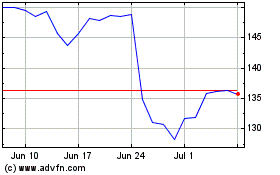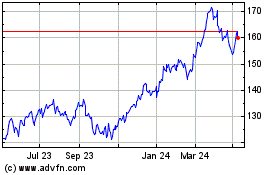SEATTLE—Boeing Co. started to make money on each 787 Dreamliner
it delivers just this spring, but thanks to a unique accounting
strategy the jet has been fattening the aircraft maker's bottom
line for years.
Boeing is one of the few companies that uses a technique called
program accounting. Rather than booking the huge costs of building
the advanced 787 or other aircraft as it pays the bills,
Boeing—with the blessing of its auditors and regulators and in line
with accounting rules—defers those costs, spreading them out over
the number of planes it expects to sell years into the future. That
allows the company to include anticipated future profits in its
current earnings. The idea is to give investors a read on the
health of the company's long-term investments.
Boeing calculates its Dreamliner earnings based on 10-year
forecasts of supplier contracts, aircraft orders and options,
productivity improvements, labor contracts and market conditions,
which are reviewed by its auditors. The company, which delivered
its first Dreamliner in 2011, estimates it will sell 1,300
Dreamliners over the 10 years ending in 2021. So far, it has
delivered nearly 500 of them.
The problem, analysts and other critics say, is that Boeing's
approach stretches its profit per plane on the Dreamliner into such
a distant and uncertain future that it isn't clear if it will ever
recover the nearly $30 billion it has sunk into producing the plane
and validate years of projected profits.
"Any estimating process that looks this far out in the future
and has this many moving parts and assumptions is almost certainly
destined to be wrong," said Carter Copeland, aerospace analyst at
Barclays Capital.
Boeing rivals Bombardier Inc. and Airbus Group SE use a
different accounting system. Both aircraft makers report losses on
new aircraft programs as they accrue during development and
production.
If Boeing similarly accounted for its planes, including the 787,
the $22.1 billion in commercial-aircraft group earnings it has
booked since 2012 would be an $1.85 billion loss, its disclosures
say.
The Securities Exchange Commission, which has broadly supported
Boeing's accounting technique in the past, began investigating
whether the company overstated elements of its accounting for the
787 project, people familiar with the matter revealed early this
year. Details couldn't be learned. Such investigations often take
years.
An SEC spokeswoman declined to comment.
Boeing, which hasn't confirmed or denied the investigation, has
defended its accounting—which complies with generally accepted
accounting principles—and says its profit expectations are
realistic. Though the Dreamliner has proved much more costly to
make than expected, the company says its cost for each 787 fell
below the selling price in the second quarter as it reaped greater
production efficiencies.
Deloitte & Touche LLP, Boeing's auditor, said it couldn't
comment on client matters.
To recover production, tooling and other one-time costs of the
Dreamliner program, Boeing's costs would have to fall fast enough
and the price it charges airlines remain high enough for the
company to make an average of $36 million profit on each of the
next 800 Dreamliners it manufactures, including 233 planes that
haven't been sold. The list price of a 787 is between $225 million
and $306 million, but airlines typically negotiate big
discounts.
If Boeing and its auditors determined that it couldn't recover
its costs over the life of its forecast, accounting rules would
require the company to declare that the program was operating at an
overall loss, and force it to take a write-off.
"They have to defend that 787 curve very tightly," said Robert
Spingarn, aerospace analyst at Credit Suisse. "You can either find
more profit...or go out and change your cost structure to get you
back on the curve."
"We continue to believe [the 787] will be a significant
contributor to Boeing's success for decades to come," Boeing
said.
Boeing, which initially expected to invest $5 billion to design
and build the carbon-fiber Dreamliner, ended up spending 10 times
that sum, after holdups and hurdles stemming from extensive
outsourcing and design issues. Compensating customers for delays
and the bargain-basement prices Boeing used to spur sales weighed
on its per-plane revenue.
Boeing originally estimated its average cost per plane would be
around $40 million, excluding engines and custom interiors, say two
former Boeing employees. Today, the 787's average production cost
is more than double that, say analysts, a sum that is only now
coming in line with the current unit cost per plane.
Boeing declined to disclose its original target for the plane,
but said its business case "anticipated correctly its overwhelming
market success."
Though it is facing a slowdown in orders for twin-aisle jets
like the 787, Boeing assumes it will continue making a dozen 787s a
month over the next decade, most of them larger and pricier
versions of the jet, and that its production costs will drop over
time. Boeing has said it is weighing the idea of making as many as
14 of the planes a month later in the decade.
The International Institute for Strategic Leadership, an
independent group of academics and executives that includes
analysts and former Boeing consultants, recently concluded that
Boeing wouldn't be able to bring down the costs of each 787 without
squeezing suppliers and would face significant pressure from Airbus
to lower the price.
In the end, whether the 787 delivers the profits Boeing has
promised may depend on how many planes it uses to average out its
costs and profits. Boeing could choose to expand that block beyond
the current 1,300 jets.
"I don't think we'll ever know because the block size will not
be static," said Mr. Copeland of Barclays.
Boeing says decisions about the block size are based on its
reasonable expectation of future sales.
Aruna Viswanatha contributed to this article.
Write to Jon Ostrower at jon.ostrower@wsj.com
(END) Dow Jones Newswires
October 04, 2016 08:05 ET (12:05 GMT)
Copyright (c) 2016 Dow Jones & Company, Inc.
Airbus (EU:AIR)
Historical Stock Chart
From Jun 2024 to Jul 2024

Airbus (EU:AIR)
Historical Stock Chart
From Jul 2023 to Jul 2024
